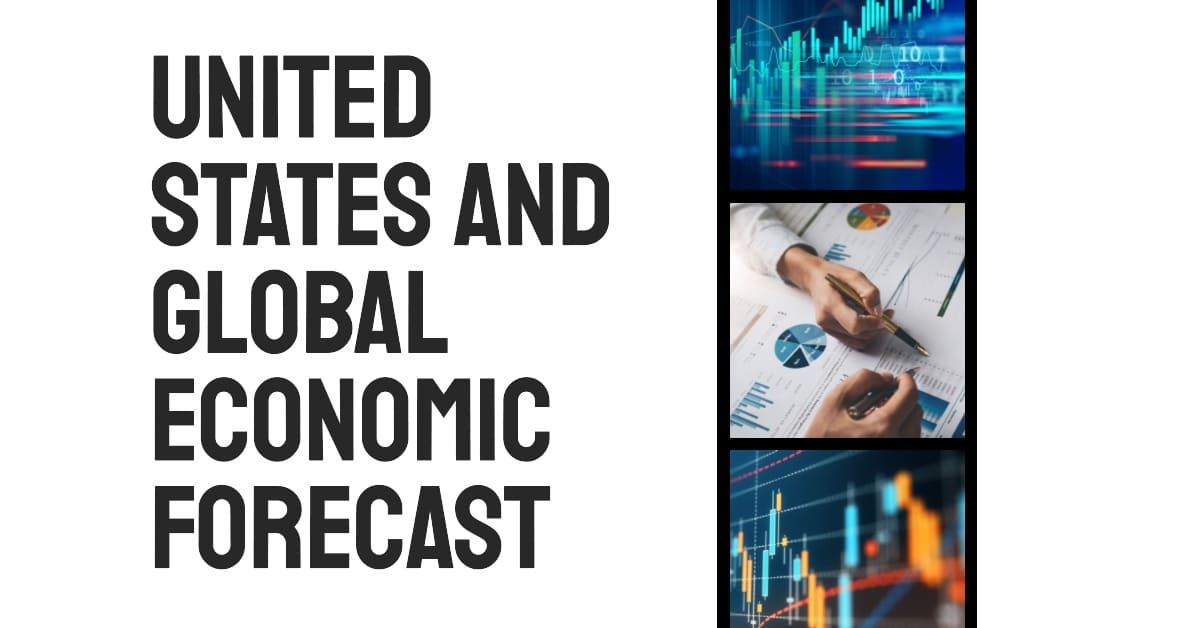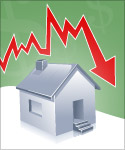In 2024, the economic landscape of the United States presents a picture of cautious optimism. The year is expected to unfold under the shadow of the previous year's economic policies and global dynamics. Here's an overview of what top financial institutions are forecasting for the US economy in 2024.
The consensus among economic experts suggests a deceleration in economic growth, with real GDP growth potentially walking a tightrope between slight expansion and contraction. After a better-than-expected growth rate of 2.8% in 2023, forecasts indicate a more modest pace of around 0.7% for 2024. This slowdown reflects the broader impact of monetary policy and the fading post-pandemic tailwinds.
The Federal Reserve's hiking cycle is presumed to have concluded, with policy rates expected to hold at 5.25%-5.5% until mid-2024. Assuming inflation continues its downward trajectory, the Fed may begin to normalize policy rates, with predictions of 25 basis point cuts at each meeting starting in June, targeting a range of 4.00%-4.25% by year-end.
The US consumer is anticipated to face challenges, with consumer spending growth likely to slow due to factors such as diminished excess savings and plateauing wage gains. Despite these headwinds, consumer spending is expected to remain positive, albeit at a lower rate than in 2023.
The fiscal boost that significantly supported the economy in 2023 is expected to reverse, potentially becoming a slight drag on the economy in 2024. The federal deficit is forecasted to narrow, reflecting a degree of fiscal restraint.
After notable declines in 2023, business investment and housing activity are set for a foundation of improved performance in 2024. However, the outlook remains cautious amid higher interest rates.
The labor market is expected to maintain its tightness, supporting employment and income levels. This stability plays a crucial role in underpinning the overall economic resilience.
Economic Forecast for the Next 5 Years
The US economy has experienced significant changes in recent years, including unprecedented events like the COVID-19 pandemic, political changes, and a global economic downturn. As we move forward, many people are interested in knowing what the future holds for the US economy over the next five to ten years.
The Conference Board expects the US economy to slow in 2024, with GDP growth under 1% in Q2–Q3, but they don't predict a recession. They also expect inflation to gradually normalize to the Fed's 2% target in 2025, and interest rates to fall starting in late 2024. The OECD projects US GDP growth at 2.6% in 2024 and 1.8% in 2025.
While they do not forecast a recession in 2024, they do expect consumer spending growth to cool further and for overall GDP growth to slow to under 1% over the Q2 to Q3 2024 period. Thereafter, inflation should gradually normalize to the Fed’s 2-percent target in 2025 as quarterly annualized GDP growth rises toward its potential of near 2%. Interest rates should fall starting in late 2024 but may stabilize at levels exceeding the pre-pandemic average.
These projections provide useful information for individuals, businesses, and policymakers as they plan for the future. However, it is important to note that economic forecasts are subject to uncertainty and can be influenced by a variety of factors, including unexpected events and changes in economic policy.
Economic Outlook for 2028 to 2033: Projections and Analysis
This section will examine the CBO’s projections for income, GDP, and the overall economic outlook for the five years, between 2028 to 2033. The CBO’s economic projections for 2028–2033 indicate that the economy is projected to grow at its maximum sustainable output. However, this projection is subject to a high degree of uncertainty, and the actual economic growth rate could be affected by various factors. Despite this uncertainty, the projections offer insights into the potential growth rate of the economy, which is an essential consideration for policymakers, investors, and businesses alike.
Projected Growth of Real Potential GDP
The CBO projects that real potential GDP will grow at an average rate of 1.8% annually between 2028 and 2033. This growth rate is similar to the average annual growth rate of real potential GDP since 2007. However, this overall growth rate conceals two distinct components of growth: potential labor force growth and potential labor force productivity growth.
The potential labor force is projected to grow more slowly annually over the 2028–2033 period than it has since 2007, on average. In contrast, potential labor force productivity is expected to grow more rapidly than it has since 2007.
Projected Growth of Real GDP
Real GDP is projected to grow at an average rate of 1.8% annually between 2028 and 2033, the same rate as real potential GDP. This projection suggests that the economy will be operating at its maximum sustainable output over the next five years. However, this projection is subject to a high degree of uncertainty.
Projections of Income for 2023 to 2033
The CBO projects that nominal gross domestic income (GDI), which represents the total income earned in the production of GDP, will grow moderately through 2033. The projection estimates that nominal GDI will grow by 3.1% in 2023, an average of 4.8% in 2024 and 2025, and an average of 4.0% from 2026 to 2033. By the end of 2025, the nominal GDI is projected to be 35% higher than it was before the pandemic. By the end of 2033, it is expected to be 85% higher than before the pandemic.
Uncertainty About the Economic Outlook
The projections offered by the CBO are subject to a high degree of uncertainty. This uncertainty stems from a range of factors, including the effect of higher interest rates on overall demand, the easing of supply-chain disruptions, and labor market participation. Additionally, the growth of potential output in the aftermath of the pandemic could be faster or slower than expected.
Understanding the US Economic Cycle
The US economy goes through a cycle of expansion and recession, which has a significant impact on the country's economic growth, employment, and overall well-being. To help policymakers, researchers, and businesses understand the current state of the economy, the National Bureau of Economic Research (NBER) maintains a chronology of US business cycles.
What is Business Cycle Dating?
Business cycle dating is the process of identifying and dating the peaks and troughs of economic activity in an economy. The NBER's Business Cycle Dating Committee is responsible for determining the beginning and end dates of recessions and expansions in the US economy. The committee's chronology helps to provide a comprehensive understanding of the US economic cycle and serves as a reference point for policymakers, businesses, and researchers.
Understanding the Business Cycle
A business cycle is a period of economic expansion followed by a period of economic contraction. During the expansion phase, economic activity, such as employment, production, and consumption, increases, leading to economic growth. However, economic growth cannot continue indefinitely, and eventually, the economy reaches its peak. At this point, economic activity begins to slow down, leading to a recession.
The NBER defines a recession as a significant decline in economic activity that lasts more than a few months, affecting the economy broadly, and spread across different sectors. In contrast, an expansion is the period between a trough and a peak, during which economic activity increases. Most recessions are brief, and the economy typically returns to its previous peak level of activity or trend path.
How is Business Cycle Dating Done?
To determine the peaks and troughs of the US economy, the NBER's Business Cycle Dating Committee uses a range of monthly and quarterly measures of aggregate real economic activity published by federal statistical agencies. These measures include real personal income less transfers, nonfarm payroll employment, real personal consumption expenditures, wholesale-retail sales adjusted for price changes, and industrial production.
The committee makes a separate determination of the calendar quarter of a peak or trough, based on measures of aggregate economic activity over the relevant quarters. Two measures that are important in the determination of quarterly peaks and troughs, but that are not available monthly, are the expenditure-side and income-side estimates of real gross domestic product (GDP and GDI).
The committee considers these measures and weighs them based on their relevance to the current economic climate. There is no fixed rule about what measures contribute information to the process or how they are weighted in the committee's decisions. In recent decades, the two measures the committee has put the most weight on are real personal income less transfers and nonfarm payroll employment.
Why Business Cycle Dating Matters
Business cycle dating is essential in understanding the current state of the economy and its historical performance. By identifying the peaks and troughs of economic activity, policymakers can develop strategies to mitigate the negative effects of economic downturns and take advantage of economic upturns. Businesses can also use this information to plan their operations and investments.
Moreover, the NBER's business cycle chronology can help researchers understand the causes and consequences of economic cycles. Studying the historical performance of the US economy can provide insights into how economic policies, technological innovations, and external shocks can affect the economy and its various sectors.
ALSO READ:
How Strong is the US Economy Today in 2024?
Economic Forecast: Will Economy See Brighter Days in 2024?
Will the Economy Recover in 2024?
Is the US Economy Going to Crash: Economic Outlook
How Close Are We to Total Economic Collapse?




